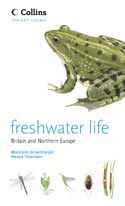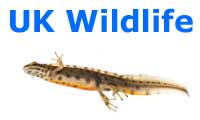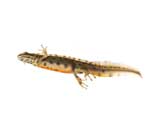Authors: Malcolm Greenhalgh, Denys Ovenden 
Pages: 256
Price: RRP £20
Availability: Still in print and available new
The book boasts on the back that it covers over 900 species, which are plants and animals, including some microscopic algae and protozoa, found in the freshwaters of Britain and Northern Europe. Of course a small ‘pocket guide’ will never be able to cover all the species you could possibly find, but this book covers a good selection.
There are 40 pages of plants, including one on alien species, over 100 pages of invertebrates and 24 pages on vertebrates. Mammals and birds are not covered, probably because these species are well covered in a number of other guides, but there are a few pages on their tracks and field signs.
There are some omissions though. There is a nice page on terrestrial/land dwelling invertebrates which often end up in the water, but it doesn’t mention groundhoppers, a species which not only live near water but often jump into it when threatened, so are more likely to be found there than some of those included
The fish section is somewhat limited too, but this is another group that is covered by many other books. The amphibians section covers all the species that occur in the UK, with illustrations of the eggs and tadpoles, and all the reptiles likely to be found in water are mentioned too
The dragonflies and damselfly adults are well covered with the important identification features highlighted, though a few of the species listed as’ not British Isles’ have started breeding here since the 2007 publication. The larvae are covered to the genus level, with the tail filaments of many of the damsel species illustrated (though it should be noted this is not a 100% reliable in all species).
Also well covered are adult mayflies and caddisflies, with some great illustrations, as are most the species in this book.
One of the problems the book faces is that many mayfly nymphs, caddisfly larvae, fly larvae, water beetles and aquatic true bugs can not be identified with 100% certainty with out careful keying out of features under a microscope. This might explain while only a few species of the many fly and beetle genera are in the book. That said species that don’t require this amount of detailed observation such as water scorpions and saucer bugs will be easily identified with this book.
To summarise, it is not a replacement for the specialised books and keys on each group, but then its doubtful one book could be. It is however a good choice for the one book to put in your field kit with your net and tray or as a first stop for that unidentified creature you have found. When asked what book is best for someone who wants to ID the creatures they are finding in their pond my first suggestion is this one.

